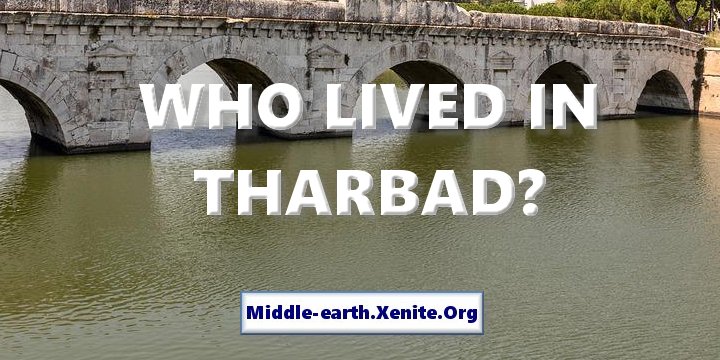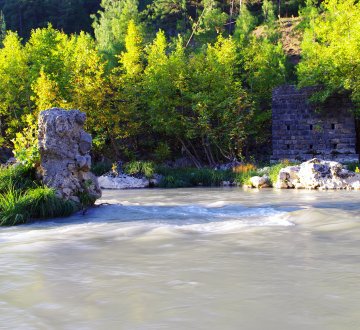
Q: Who Lived In Tharbad?
ANSWER: Tharbad comes up every now and then in online discussions. I’ve received a few questions about it across the years, too. It’s an intriguing town because readers of The Lord of the Rings only know one real detail about its history: when the town was abandoned (Third Age Year 2912). If you read Unfinished Tales of Numenor and Middle-earth you’ll learn a little bit more about Tharbad, but not much.

The name is derived from Sindarin thara + pata, and it could be the name of an ancient ford across the Gwathlo river. Even though J.R.R. Tolkien wrote a note indicating that Aldarion of Numenor met Galadriel at Tharbad, he never developed the idea into a story. At best we can infer that Tharbad was a place (during the early Second Age) that would have been used by Elves passing between Gil-galad’s kingdom in Lindon and the realm of Eregion.
It kind of makes sense that Tharbad would be an elvish outpost. But it doesn’t have to be. It could just be a place where the river flows through rocks, making it possible for people and horses to pass over the river.
Tharbad could also have been a human settlement or a dwarf settlement. It could have been comprised from the start of various peoples coming together for trade and/or mutual defense.
Judging by the “non-canonical” history given in Unfinished Tales, we know that Tharbad was defended by Gil-galad and the Numenoreans. And it was a strategic landing point for Numenor’s reinforcements during the War of the Elves and Sauron. One can logically infer there must have been a haven at Tharbad, or at least a road, that the Numenoreans wanted to use. They need to move an army up behind Sauron’s forces and Tharbad would be a sensible landing point if it had a haven and/or access to a major road.
When Elendil established Arnor near the end of the Second Age he included Tharbad in his realm. According to Unfinished Tales Arnor established a garrison on the north side of the river and Gondor established a garrison on the south side of the river. The southern garrison makes sense because Gondor never pacified the Gwathuirim who lived in what later became known as Dunland (a named bestowed upon the region by the Rohirrim). But why did Elendil maintain a garrison on the north side of the river? Were Tharbad’s inhabitants threatened by indigenous peoples within Minhiriath?
It’s conceivable that Tolkien only imagined Arnor and Gondor spreading their forces around the countryside out of prudence. It would be easier to maintain small garrisons from local supplies. And they could provide necessary border security against random wanderers and vagrants. Arnor’s huge army from the War of the Last Alliance of Elves and Men was gathered and trained at Rivendell, and after the war the survivors returned to their prior lives.
The last confirmed date for a garrison at Tharbad was Third Age year 1636, when the Great Plague swept across the western lands. Gondor withdrew its forces from Mordor and Tharbad. It’s not clear what exactly happened with Aglarond and Angrenost, but they retained some sort of “hereditary” garrisons for more than 900 years. It would seem that Enedwaith remained a threat to Gondor, thus requiring that Calenardhon be defended against the Gwathuirim.
In Minhiriath we know about one group of Gwathuirim who lived in Eryn Vorn at the time of the War of the Ring. They were independent of any other group of men at that time. Tolkien only says of them that they lived in the woods and were not organized. I have always inferred from his description of the Men of Eryn Vorn that they had no villages, no chieftains, and thus no army. But I suppose they could have been a remanant of a larger group of Gwathuirim who did not acknowledge the High Kings at Annuminas or their successors in Cardolan and Arthedain.
Hence, maybe Tharbad required defenses against occasional raids from the vicinity of Eryn Vorn. But I think that unlikely.
Maybe there were orcs in the Misty Mountains who came down into the Angle and beyond, thus approaching Tharbad. That seems reasonable but the Longbeard Dwarves retained control over the Misty Mountains until Third Age year 1981, when the Balrog destroyed their civilization. Orc raids into Eriador would still be possible, but Tharbad seems like an out-of-the-way place to me.
So I really have no idea of why Arnor and Cardolan would maintain a garrison at Tharbad. They did. Presumably that garrison was destroyed or disbanded after Third Age year 1974, when Angmar overran the northern kingdom. Some people guess, or hope, that Tharbad remained an independent city-state after the end of Arthedain/Arnor. But if so, then why didn’t Aranarth name himself Lord of Tharbad? Why didn’t Tolkien say he moved his seat to Tharbad?
The circumstantial evidence suggests that even if Tharbad had survived as a substantial town until the fall of Arnor, the town probably never fully recovered after the war. It could also be that Tolkien meant for people to resettle Tharbad.
And who would those people be? Probably not elves. Maybe a few Dunedain chose to live there. Certainly men related to the Gwathuirim (including the Men of Bree) could have settled there.
We sometimes speculate that Thrain II and Thorin Oakenshield lived closed to Tharbad when they settled in Dunland. But we don’t really know where they lived or whom they were doing business with. One would guess that if Dwarves were in Dunland they were doing smithy work for the Dunlendings. I imagine the Rohirrim would not be happy about that, given their long history of conflict with the Dunlendings. According to “Durin’s Folk” in Appendix A in The Lord of the Rings, Thrain II lived in Dunland from some time prior to Third Age year 2790. Although Thrain led the Dwarves in their war with the Orcs (Third Age years 2793-99), he moved to Eriador sometime after returning home.
The Rohirrim fought a war with the Dunlendings from 2758 onward, so the Dwarves of Dunland might have been helping the Dunlendings. But the Rohirrim were more concerned with Orcs fleeing the northern war after T.A. 2800.
SEE ALSO:
- What Is the History of Tharbad?
- Do You Have a Map of Tharbad?
- What Tharbad Ever An Independent City-state?
- Who Ruled Cardolan, Land of Red Hills?
- What Was the Capital of Cardolan?
# # #
Have you read our other Tolkien and Middle-earth Questions and Answers articles?

“Some people guess (…) that Tharbad remained an independent city-state (…). But if so, then why didn’t Aranarth name himself Lord of Tharbad? Why didn’t Tolkien say he moved his seat to Tharbad?”
Isn’t this actually an argument in favor of Tharbad being an independent city state? If it would have stayed a part of Arnor, then I could imagine king Aranarth moving his seat to Arnor, but if it is independent, then wouldn’t he be less able to claim the city as his seat?
I could be 100% wrong, but I always thought that the simplest explanation for why a garrison would be maintained at Tharbad would be to deal with “internal” threats to Arnor, not external ones. Much like Gondor, Arnor wasn’t completely empty when Elendil and Sons fled Numenor. Granted, a lot of the population had Numenorean admixture from literally millenia of contact at that point, but you almost certainly had seperate identity of the locals, or lots of little regional separate identities.
Then after the Downfall, you have the formation of Arnor and Gondor, which wind up claiming a truly massive amount of territory. Territory, which again, was not empty. We have no details on how exactly the first Kings of Arnor wound up in control, but it’s certainly very plausible that some amount of conquest, or at least implicit use of force (We’re overwhelmingly powerful Numenoreans, we’re in charge now) existed, and there was some undercurrent of unrest from the native population, which in turn would require garrisons spread out across the realm to deal with rebellions or the threat of rebellion.
The answer to “Who lived there” seems simple to me; people who lived on trade/commerce. When that dried up, so did the city. And I do say city, rather than “ruined town” as it was described in The Ring Goes South. Though not of the scale of southern cities, it had so many natural advantages that it must have once been one of the Northwest’s principal settlements.
Cities grow up at the crossroads of trade routes, such as the intersection of the great North Road and the region’s largest navigable waterway. Why did the road cross there? It was likely the first spot inland from the sea where a ford/bridge was practical. With a bridge or ford to connect them settlements can thrive on both banks. For examples in Tolkien’s real-life backyard look to London, Liverpool, Glasgow, Dublin, and even historic Chester before the River Dee silted-in. How important was Greyflood in its heyday? Not only did it have Tharbad, but Lond Daer at the river’s mouth. On Tolkien’s maps only Anduin, with Pelargir and Osgiliath/MinasTirith, matches Greyflood in supporting two or more named seaports/river crossings.
Why separate garrisons? Political and strategic reality. Trade between Arnor and Gondor was dependent on that river crossing. Both sides had a stake in its ongoing security.
When the Númenóreans began to spread their influence along the seacoast, navigable rivers made it easy to extend that influence inland. Where their ships could go no further, they’d likely build a port, garrison, and trading post. Tharbad’s advantage continued for as long as Gondor was a viable seagoing nation. The Port of Tharbad was roughly equidistant from Bree, the Southfarthing, and Eregion/Moria Gate, not to mention most of what would become Dunland. Geography alone tells me that it had to have been more prosperous and populous than the Esgaroth/Dale Metropolitan Region.
With such natural advantages, I’ve always taken Tharbad’s abandonment to be as emblematic of the Dúnedain’s fall as the ruins of the Barrow Downs, Weathertop, Fornost, and Annúminas.
Any thoughts about the existence of a possible dwarf colony in Dunland? did you think that Thrór had mines there?